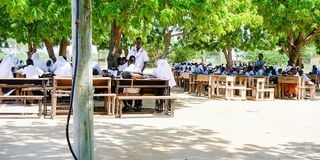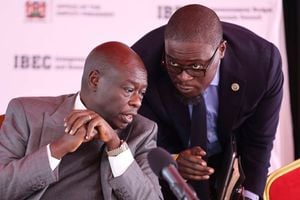Report lays bare the disparities between boys and girls schools

Pupils at Makere Primary School in Tana River County.
A new study interrogating gender equality in Kenya’s education sector shows that more boys of school-going age are out of school.
The study report shows that on average, school-aged boys were 1.2 per cent more likely to be out of school than girls. It also shows that the percentage of boys out of school was much higher at 10.4 per cent in female-headed households than in male-headed ones. The percentage of girls out of school was however the same in both male- and female-headed households.
The Gender Report, 2024: What is the State of Gender Relations Transformation in Our Basic Education?, also indicates that 19 percent of pre-school children and children of primary school age were out of school, respectively.
The study, conducted in June and July last year by Usawa Agenda in conjunction with Echidna Giving, Wellspring Philanthropic Fund and Imaginable Futures, covered 39,298 children aged 6-15 years, and 1,813 primary and 1,342 secondary schools across all the 47 counties.
The study also lifted the lid on perceived favouritism towards boys’ secondary schools, which were almost 10 percent more likely to be offering computer lessons than girls’ secondary schools. Boys’ secondary schools were almost three times more likely to offer computer lessons than mixed secondary schools.
According to the report, boys’ schools were also more likely to own a laboratory than girls’ and mixed schools. The study found that 61.5 percent of boys’ schools own a chemistry laboratory compared to 42 percent of girls’ schools and 20.6 of mixed schools.
A higher number of boys’ secondary schools (63.5 percent) were found to have functional libraries compared to girls’ secondary schools at 46.6 percent and mixed secondary schools at 25.5 percent. However, a higher number of girls’ secondary schools had libraries linked to online resources compared to boys’ schools at 23.2 percent.
The report released in Nairobi on Thursday reveals a dire situation for girls when it comes to scholarships and bursary allocation, with 4.7 percent of student beneficiaries in boys’ secondary schools receiving more than Sh30,000 compared to 3.7 percent of beneficiaries in girls’ secondary schools.
It further revealed that women form the majority of teachers in primary schools, but men manage the schools.
About 56.6 percent of primary school teachers were found to be women, but only 32.3 percent and 14.4 percent of school heads and board of management chairpersons were women.
When it comes to secondary schools, 41.8 percent of teachers were women, but only 33 and 15.7 percent of the school heads and board chairpersons were women, respectively.
The study also shows that more men than women teach in secondary schools. However, women are underrepresented in the management of secondary schools, except for girls’ schools where 66.7 percent of the school heads were women. But even for girls’ schools, only 28.4 percent of their board chairpersons were women.
When it comes to school health and safety matters, the report indicates more boys’ schools (85.3 percent) had medical personnel than girls’ secondary schools at 55.6 percent.
On cleanliness, 30.8 percent of boys’ schools were cleaned by school employees, which is more than twice the percentage for girls’ schools (15.3 percent).
An estimated 19,230 teenage girls, the study revealed, were reported pregnant, with the Rift Valley region contributing the most to the national teenage pregnancy burden at 35.8 percent, while the North Eastern region contributed the least at 0.07 percent.
Nationally, only 42.5 percent of girls who were reported pregnant reported to school after delivery to continue with their studies.
Speaking during the launch of the report, Nominated Senator Peris Tobiko said the research findings should help to bring about gender equality in the education sector in the country.
“We must allow and create an opportunity where both boys and girls pursue subjects that were traditionally seen to be done by one gender, like STEM (science, technology, engineering and mathematics) subjects. The Senate committee notes with satisfaction the efforts of Usawa Agenda in availing data that will help to bridge the gap between policy and practice,” said Ms Tobiko who is the Vice-Chairperson of the Senate Education committee.
She emphasised the need to ensure boys and girls in the country have equal access to education.
National Gender and Equality Commission CEO Purity Ngina said it was sad to note that boys’ schools were being favoured in terms of infrastructure at the expense of girl’s schools.
“It is like the system is designed to disadvantage girls from achieving their potential, especially on equipping girls’ schools with laboratories and other essential facilities necessary for STEM subjects. As a country, we need to ask ourselves what should and must be done to end this disproportion,” Dr Ngina said.
Usawa Agenda Executive Director Emmanuel Manyasa said the findings of the report highlight the wide gap between what our education system offers to the majority of Kenyan children contrary to the desired gender transformative education.
“Studies in Kenya have found that girls outperform boys at the primary school level but boys end up posting better learning outcomes at the secondary school level. “What changes along the way is the big question that Kenyans must ask themselves,” Dr Manyasa said.
He added that evidence points to a differential investment in girls’ and boys’ schools in favour of boys’ schools at higher levels, which could explain the achievement gaps in favour of boys.
He called on all the relevant stakeholders to make the necessary changes to achieve gender equality in the education sector.
“We will be coming up with two policy briefs out of the report on schools leadership and safety. Some schools are just death traps. They have no places to escape through in case of an emergency. Other schools do not have even a single woman in their board of management,” he added.
Dr John Mugo, the Executive Director of Zizi Afrique Foundation, said there cannot be education justice without gender justice.
“The number of teenage mothers going back to school to continue their studies is very low. We need to enable girls to go back to school for education,” said Dr Mugo.




